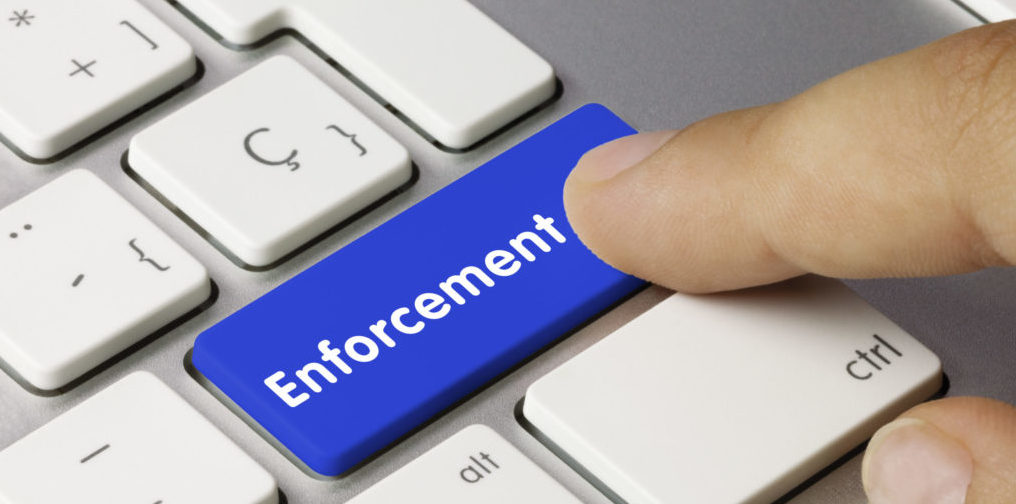
Congratulations! You’ve made it to the course’s final lesson, which means you’ve learned a great deal about reseller pricing policies. Although this is only an introductory-level course, you probably already have a better practical understanding of how these policies work, and how to run them successfully without falling into the common legal traps, than most professionals at most brands and manufacturing companies.
For this final course, we’re going to give you an overview of the steps and best practices to put your company’s policy into action. So, let’s assume you’ve drafted and published a MAP or MRP policy, and now it’s time to put processes into place to make sure the right people, using the right automation tools, are monitoring your resale network at all times and enforcing your policy’s guidelines.
But before we dig into these recommendations for implementing, monitoring, and enforcing your policy, we want to underscore one last time that an effective reseller pricing policy will always be a companywide effort. Let’s briefly review which individuals and departments in your organization you’ll need to involve, and the types of responsibilities they’ll all have.
Who Will Have What Role in Rolling Out Your Policy?

The following breakdown of roles and responsibilities is only one way a manufacturer might choose to handle managing its reseller pricing policy. You can assign these roles in any way you choose, but it’s important to note that these tasks and roles need to be assigned and the people responsible need to be accountable for them.
The sales department
A manufacturer’s in-house sales department is often the initial driver at the company for adopting a MAP or MRP program, because they’re having difficulty selling products to their distributors or wholesalers (who can no longer compete with rogue sellers and don’t see any help coming from the manufacturer).
The sales department can help roll the policy out to the company’s existing resale network and develop a process for always sending it to new retailers as they join the Authorized Dealer Program. The department should also educate its reps on what to communicate to resellers regarding the policy, and, more importantly, when to avoid having discussions about the policy and instead handing it off to a designated policy administrator.
The eCommerce department
If a company has its own eCommerce sales team, that department will have to police itself against violating its own MAP or MRP policy. These reseller policies succeed only to the extent that everyone must follow them, including the manufacturer itself.
The marketing and product teams
The marketing department can help both in crafting the messaging, to position the company’s MAP-covered products as “premium,” and in managing some of the policy’s enforcement levers, such as adding repeat violators to an internal “Do Not Sell” list and warning in-house reps and distributors not to sell inventory to these resale partners.
The product team often helps determine which products or SKUs should be included in a reseller pricing policy and which shouldn’t.
The executive staff
The company’s senior management team should take an active role in communicating regularly to the rest of the organization the importance of actively monitoring and enforcing its reseller pricing policy. One concrete step the executive staff, or perhaps a designated executive sponsor, can take is to periodically send out internal updates about the company’s enforcement successes and the results they’re having on protecting reseller margins and the company’s brand image.
The organization will take monitoring and enforcement more seriously to the extent that the company’s leadership team shows they view it as a high priority.
The legal team
If the company has an in-house (or outside) legal team, these attorneys will help the organization develop its MAP or MRP policy and, ideally, will continue to advise the company on how to enforce it such that the company avoids any legal pitfalls.
The customer service department
The customer support team will need to be in the loop on which retailers have violated the company’s pricing policy and how to communicate with these retail partners when they call. They will also need to be trained on how to handle general inquiries from resale partners such as special circumstance requests for exceptions to the pricing policy’s guidelines.
These retailer inquiries will in some cases come into the manufacturer’s support team—particularly if resellers know the company’s sales department has been instructed not to make exceptions to its reseller pricing policy. Ideally, the company will train its customer support agents not to address these inquiries directly but instead to redirect them all to the company’s Policy Administrator.
The Policy Administrator
Selecting a designated MAP or MRP Policy Administrator is a best practice and one we highly recommend. The primary advantage is that this person can help the company avoid inconsistently handling its pricing policy by allowing different people (in sales, in eCommerce, in customer support, etc.) to make different arrangements with different resellers, which could put the company in legal jeopardy.
When a manufacturer has a designed administrator overseeing its reseller pricing policy, all employees in the company will have a simple answer to the often-difficult requests that come in from resellers: “Let me direct you to our Policy Administrator.”
Best Practices: Implementing and Monitoring Your Policy

Okay, let’s dig into the major steps and smart strategies for putting your new reseller policy into action. We’ll start with the rollout and monitoring stages, the conclude with best practices for effective enforcement.
Establish your search criteria for tracking product information online.
The first step in developing your policy’s implementation and monitoring process is to build a comprehensive set of identifiers relating to your product info. This might include a wide range of product-specific numbers: SKUs, ASINs (for Amazon), ePIDs (for eBay), GTINs, UPCs, your own unique manufacturer serial numbers, or any form of identifiers you use to label and track your products. You might also have specific trademarked text, proprietary imagery or videos, or other product-related intellectual property that helps you quickly spot your product represented in an advertisement or on a reseller’s sales page. And speaking of resellers, perhaps you also have a list of authorized dealers or retailers. You’ll want to gather up all of this data, and use it as the basis of your resale-channel monitoring process.
Set a structure, cadence, and resources to scan for pricing violations.
Now that you have the data sets you’ll be using to monitor your products across the internet, you’ll need to establish a structure for how to most efficiently and effectively search for that information. You don’t simply want your team to randomly type in the names of a handful of your products or a few ASINs whenever they have a few free minutes to look for possible reseller pricing violations. That process would be neither systematic nor effective. So you’ll need to think this through. You’ll want to consider questions such as:
Do you want to repurpose an employee, or several, to monitor the Internet at specific times of each day?
How do you want these in-house team members actually conducting their monitoring? Should they view each authorized reseller’s own eCommerce pages each day? More than once a day? And at what times of day?
What if a reseller pops up somewhere new in an online marketplace and your team misses it or they change their pricing throughout the day? Will you want your in-house team also conducting random (or systematic) checks for unfamiliar resellers offering your products on various marketplaces?
Do you instead want to deploy an automated platform for policy monitoring?
Set your monitoring process to catch every type of violation in your policy.
Let’s say you roll out a MAP policy that forbids retailers from presenting shoppers with a “Click for best price” offer if the in-cart price drops below your MAP-approved level. (Remember, with a MAP policy, you’ll have the freedom to allow or disallow in-cart pricing to dip below your approved prices.) Your MAP monitoring process will need to include searching for these harder-to-catch violations as well. Now you will need to build into your instructions for your employees—or set instructions for your automated price protection platform—to check each site featuring your products not only for advertised prices on the main sales page but also for that “best offer” price hidden behind a click. As you can see, these added steps make manual, in-house MAP monitoring even more time consuming and less efficient.
Establish a system for documenting violations.
The next logical step in creating your MAP monitoring strategy is to decide how you want to document a violation. This step should not focus on how to actually deal with the violator; that will be a function of your enforcement strategy. Here, you’re concerned only with making sure that any time your team (or your price-monitoring software) catches a violation of your policy, you have a systematic approach to gathering the evidence you’ll need either to 1) approach the violating reseller, or 2) support your legal action against the reseller, if it comes to that. At a minimum, we recommend taking a screenshot of the offending page (time-stamped, if possible) to prove the pricing violation took place. We also suggest an immediate check of all of that reseller’s other pages and of the major online marketplaces (Amazon, eBay, etc.) where they might have a presence. If they are violating your policy on one site, you have every reason to believe they are doing it elsewhere, or will shift their activity once they know that they’ve been found out.
Bottom line: automation is key
As these steps should make clear, trying to implement and monitor a pricing policy manually is neither efficient nor the best way to create a policy that works. This is why the smart move is always to automate as much of the process as possible, ideally with an online price-monitoring and brand protection platform.
Best Practices: Enforcing Your Policy

Now, assuming you’ve established an effective and efficient system for monitoring your products’ presence across the internet at all times, your next question should be: What happens when we actually catch a violation? Here are some best practices for smart policy enforcement.
Develop separate strategies for responding to authorized and unauthorized resellers.
One persistent myth in brand protection discussions is that manufacturers must respond identically to all offenders—or they risk appearing to favor certain companies over others, which could be deemed an antitrust violation. While it is true that you cannot set up a pricing policy and then selectively enforce it—punishing certain resellers while allowing others to violate the policy—the truth is you will need to deal with different types of retailers in different ways. For example, if you’ve set up some form of Authorized Dealer Program, that means that some resellers—the grey-market operators who aren’t part of your program—will be selling your products without your permission. For these retailers, you can take aggressive action without fear of antitrust issues because by definition your issue with those companies will be a question of authorization—not price. When you catch these unauthorized retailers selling your products, you can send cease-and-desist letters and other notices threatening legal action. You don’t have to treat these companies the same way you’d treat an authorized dealer that runs afoul of your policy, because they have no business selling your products in the first place. With an authorized reseller, on the other hand, you’ll need to be far more careful in how you address a violation. You might want to simply remove such a company from your Authorized Dealer Program after their first violation. Or you might want to set up a graduated enforcement plan, where after one violation you’ll institute certain consequences—for example, suspending their access to inventory for 60 days and then removing them from your authorized list if they commit a violation a second time. You will need to enforce your consequences consistently for this subcategory of reseller.
The point here is that you do not—and should not—treat all reseller violations identically. Unauthorized resellers do not need the same antitrust consideration that your legitimate resale channel requires. But when it comes to your authorized resellers, you will need to enforce your policy consistently.
Send formal enforcement notifications to violators—but do not discuss them.
Let’s say your team catches a reseller offering your products on their website for a price below your policy’s approved price. Let’s also assume you’ve decided that your enforcement policy will be to immediately cut off such a reseller’s access to inventory and remove them from your authorized list. How do you actually execute on that enforcement strategy? The best practice here is to simply send a formal notification to the company. This notice should restate your policy’s consequences for violating its rules (removal from your channel). It should also show evidence of where the reseller violated that guidelines (using the documentation you’ve compiled). It should then state that the reseller is now officially removed from your authorized list and is no longer allowed to sell your products. You should instruct your team not to speak with any representative of the reseller’s company by phone, exchange emails with the company (even if only to reiterate the fact that they’re being terminated from your network), or engage in any type of communication after the termination. Why? If your reseller ever challenges you in court over this termination, you don’t want to give them any ammunition to demonstrate that you are willing to discuss or negotiate your policy with a reseller. Furthermore, if your company ever decides unilaterally to reinstate the reseller, you also need to be able to demonstrate that your decision was indeed unilateral — that you had no discussions, negotiations, or communication of any type with this company regarding their termination. Keep in mind also that if another reseller you’ve terminated for similar reasons ever decided to challenge your decision legally, they could subpoena communications from other resellers. This could mean that any communication you’ve ever had about your policy with another reseller you terminated and then reinstated could support the claim that you are playing favorites and possibly violating antitrust law.
Avoid referencing “pricing” in your communications about a reseller’s violations.
You might have noticed that in the previous tip we recommended you refer in your communications with a violator only your policy’s consequences in general. We did not suggest you specifically state that your resale partner violated your “pricing guidelines”. This is particularly important if your policy will allow a violating reseller to redeem itself in your Authorized Dealer Program after a period of suspension. Here’s why. When you refer in your message to a policy violator that they’ve disobeyed your “pricing” guidelines and will need to take the following steps to get back into your company’s good graces as a retailer in good standing, the law could perceive that as stepping close to the line in establishing a pricing agreement. That’s risky legal territory. It is safer and smarter to refer to offenses against your MAP or MRP, even if they are clearly price-related, only as “branding-guideline violations” or “violations of your retailer policy guidelines.”
Prepare as much of your enforcement material as possible beforehand.
When your team catches a violation, you don’t want them to have to guess about what their next move should be. You don’t want an employee drafting and sending off ad-hoc warning notices to every violator, either. You need to systematize as much of your enforcement process as possible. This means, for example, drafting legally sound boilerplate language for:
Your first warning notice (which you can lightly customize for the specific company, as long as the customization doesn’t materially change the warning’s language).
A cease-and-desist letter for unauthorized retailers (which you can lightly customize for the specific company, as long as the customization doesn’t materially change the warning’s language).
A removal-from-network letter to an authorized reseller you are terminating (which you can lightly customize for the specific company, as long as the customization doesn’t materially change the warning’s language).
Your standard response to inquiries about your reseller policy—which should not discuss or offer additional information about the policy but should instead direct the inquirer to either an FAQ page about your policy or to your company’s primary Reseller Price Policy contact person, ideally your Policy Administrator.
You will of course need to prepare more documents than this, and you will need to decide in advance who at your company will be responsible for reviewing each violation to determine which enforcement action to take.
This should give you an idea of why it’s so important to automate the process to whatever extent possible. The business and legal implications of incorrectly enforcing your pricing policy are too risky to leave these decisions to a case-by-case basis or let your company’s actions be dictated in part by which employee happens to catch the violation.
Almost done! Just one last quiz, to test what you’ve learned about implementing, monitoring, and enforcing a reseller pricing policy.
